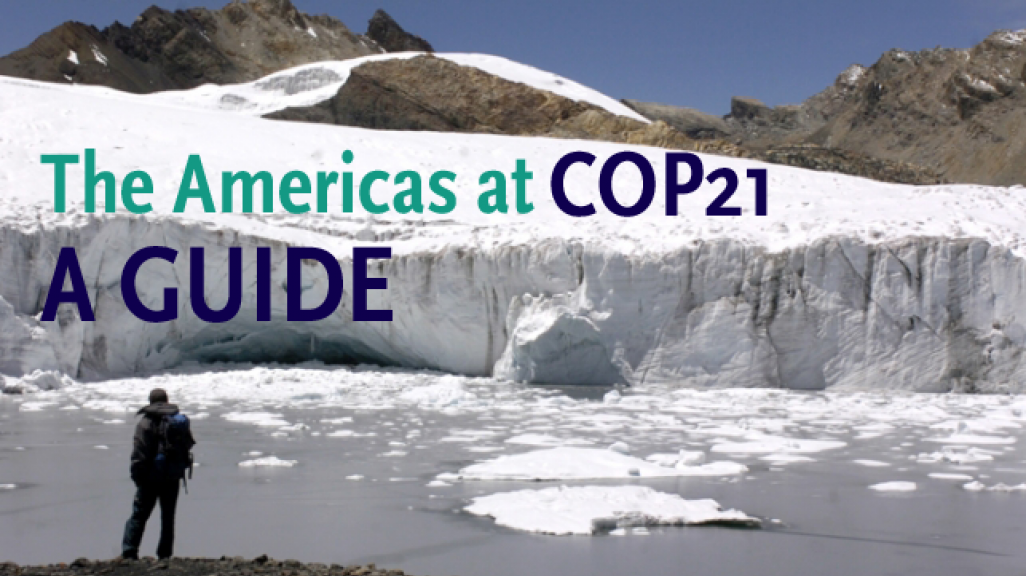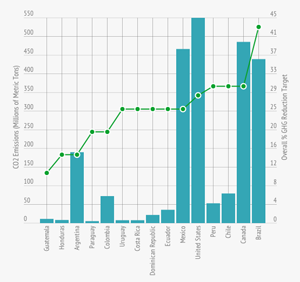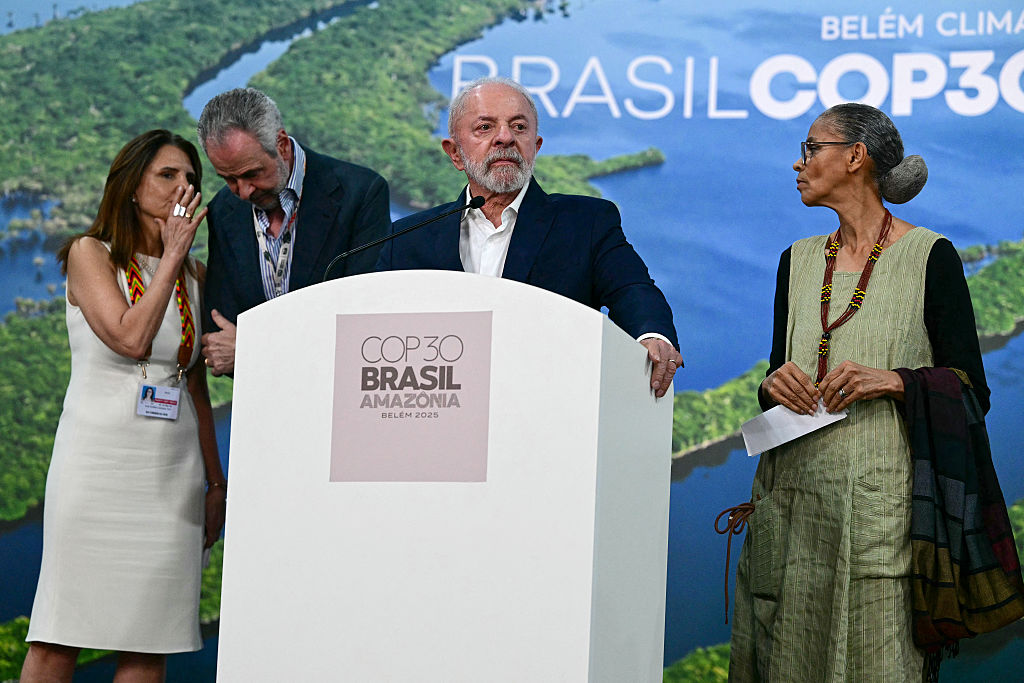Guide: The Americas at COP21
Guide: The Americas at COP21
Ahead of the Paris meeting, get a rundown of the commitments Latin American countries have made to reduce greenhouse gas emissions.
Once again, country leaders will gather for the UN's annual Conference of the Parties, this year held in Paris from November 30 to December 11. Since 1995, the COP, as the meeting is most commonly referred to, seeks to bring the countries of the world together to tackle the ever-increasing risks of climate change. This year's COP21, however, will mark a turning point as it seeks to finalize a legally binding agreement—the first in 20 years—that will commit countries to keep global temperatures from rising more than 2°C (3.6°F) above preindustrial levels by reducing harmful emissions into the atmosphere. AS/COA Online offers a guide to the Americas' role in the meeting.
Annex Categories: The UNFCCC divides the 196 parties to the convention among three categories: Annex I, Annex II, and Non-Annex I. Annex I and Annex II countries are industrialized countries of the OECD, while Non-Annex I countries are developing countries. The UN gives Non-Annex I countries some leeway in terms of their INDCs, given that these countries have fewer resources.
Carbon Neutrality: To be carbon neutral is to have zero net carbon emissions, meaning the carbon emissions a country releases are offset by sequestration, which captures carbon, or by carbon credits.
Greenhouse Gases (GHG): These gases capture heat in the earth's atmosphere and include carbon dioxide (CO2), methane, nitrous oxide, hydrofluorocarbons, perfluorocarbons, and sulfur hexafluoride. While these exist naturally in our atmosphere, they are exacerbated by human activities like burning fossil fuels, deforestation, and agricultural practices.
Intended Nationally Determined Contributions (INDCs): All countries were asked to submit their INDCs ahead of COP21, stating mitigation and adaptation goals that will help combat global warming. The main component is a target percentage by which to reduce the emissions of greenhouse gases.
UN Framework Convention on Climate Change (UNFCCC): Before COP, the UNFCCC established the first framework for overseeing greenhouse gas emissions.
CO2 Emissions in 2011: 190,035,000 metric tons
INDC Emissions Target: Reduce overall greenhouse gas (GHG) emissions 15 percent by 2030, based on 2005 levels.
Other: Argentina would increase this commitment to 30 percent if certain conditions are met, such as adequate international financing, support for innovation and technology development, and support for capacity building.
Bolivia
Non-Annex I
CO2 Emissions in 2011: 16,120,000 metric tons
INDC Emissions Target: Citing its lesser development and low ecological footprint, Bolivia offered no specific target for emissions reduction.
Other: Bolivia's commitments focus on water resiliency, increasing the participation of renewable energy in the energy matrix to 79 percent by 2030, and reaching zero deforestation by 2020, among others.
Brazil
Non-Annex I
CO2 Emissions in 2011: 439,413,000 metric tons
INDC Emissions Target: Reduce overall GHG emissions 37 percent by 2025 and by 43 percent in 2030, based on 2005 levels.
Other: Even before submitting its INDC, Brazil made significant progress, reducing emissions by approximately 41 percent from 2005 to 2012. Among other goals listed in its INDC, Brazil intends to expand renewable energy sources so they make up 45 percent of the energy matrix, compared to 40 percent today.
Canada
Annex 1
CO2 Emissions in 2011: 485,463,000 metric tons
INDC Emissions Target: Reduce overall GHG emissions 30 percent by 2030, based on 2005 levels.
Other: In its INDC, Canada notes it has already lowered GHG emissions by 3.1 percent from 2005 to 2013.
Chile
Non-Annex I
CO2 Emissions in 2011: 79,409,000 metric tons
INDC Emissions Target: Reduce overall GHG emissions 30 percent by 2030, based on 2007 levels.
Other: This commitment could be up to 35 to 45 percent of emissions reduction conditional upon international funds. Chile’s INDC also commits to restoring approximately 247,000 acres of forest between 2020 and 2030.
Colombia
Non-Annex I
CO2 Emissions in 2011: 72,423,000 metric tons
INDC Emissions Target: Reduce overall GHG emissions 20 percent by 2030, based on 2010 levels.
Other: This commitment could be up to 30 percent, conditional on international support.
Costa Rica
Non-Annex I
CO2 Emissions in 2011: 7,844,000 metric tons
INDC Emissions Target: Reduce overall GHG emissions 25 percent by 2030, based on 2012 levels.
Other: Since 2007, Costa Rica has been working to become a carbon neutral economy by 2021.
Cuba
Non-Annex I
CO2 Emissions in 2011: 35,922,000 metric tons
INDC Emissions Target: Citing a low carbon footprint and lack of international financial support, Cuba did not submit a specific emissions reduction target. It will, however, consider commitments depending on a Paris accord.
Other: Cuba does propose other commitments, such as increasing renewable energy resources by building 75 small hydroelectric power stations and 13 wind farms, among other projects. Overall, these projects are expected to cost at least $4 billion, contingent on international financial support, and are expected to reduce CO2 emissions of 6 million metric tons by 2030.
Dominican Republic
Non-Annex I
CO2 Emissions in 2011: 21,888,000 metric tons
INDC Emissions Target: Reduce overall GHG emissions 25 percent by 2030, based on 2010 levels. This target is conditional upon favorable and predictable support, feasible climate finance mechanisms, and improved market mechanisms.
Ecuador
Non-Annex I
CO2 Emissions in 2011: 35,728,000 metric tons
INDC Emissions Target: Reduce overall GHG emissions 25 percent by 2025, based on 2011 levels.
Other: This commitment could increase to between 37.5 and 45.8 percent, contingent upon the availability of international resources. Ecuador also intends to derive 90 percent of its electricity from hydroelectric plants. The country will combat deforestation with plans to restore some 1,200,000 acres of forests by 2017 and an additional 247,000 acres every year after that until 2025.
El Salvador
Non-Annex I
CO2 Emissions in 2011: 6,685,000 metric tons
INDC Emissions Target: El Salvador did not set a specific emissions reduction target in its INDC, though it will review and update its INDC based on the Paris accord.
Other: El Salvador proposes other commitments incorporated into its national development agenda. These include work to increase renewable energy resources, reducing the vulnerability of the agricultural sector, and improving water conservation and sustainability.
Guatemala
Non-Annex I
CO2 Emissions in 2011: 11,258,000 metric tons
INDC Emissions Target: Reduce overall GHG emissions 11.2 percent by 2030, based on 2005 levels.
Other: This commitment could be up to 22.6 percent conditional on the technical and financial support of international resources. Guatemala also plans to get 80 percent of its energy matrix from renewable sources by 2030, up from 70 percent now.
Honduras
Non-Annex I
CO2 Emissions in 2011: 8,412,000 metric tons
INDC Emissions Target: Reduce overall GHG emissions 15 percent by 2030, based on 1995–2012 levels.
Other: Honduras is aiming to restore one million hectares of forest by 2030 as well.
Mexico
Non-Annex I
CO2 Emissions in 2011: 466,549,000 metric tons
INDC Emissions Target: Reduce overall GHG emissions 25 percent by 2030, based on 2013 levels. Mexico’s 25 percent unconditional commitment takes into account a 51 percent reduction in black carbon.
Other: This commitment could go up to 40 percent contingent upon an international agreement addressing the global carbon price, carbon border adjustments, technical cooperation, access to low-cost financial resources, and technology transfer, among other topics. Mexico also aims to reach zero deforestation by 2030.
Nicaragua
Non-Annex I
CO2 Emissions in 2011: 4,899,000 metric tons
INDC Emissions Target: Nicaragua has not submitted an INDC.
Panama
Non-Annex I
CO2 Emissions in 2011: 9,666,000 metric tons
INDC Emissions Target: Panama has not submitted an INDC.
Paraguay
Non-Annex I
CO2 Emissions in 2011: 5,299,000 metric tons
INDC Emissions Target: Reduce overall GHG emissions 20 percent by 2030 based on 2000 levels. Half of this commitment level is conditional upon international support and the exchange of technology.
Other: Paraguay incorporated the INDC in its National Development Plan, which also stipulates that the participation of renewable energy sources in the country's energy consumption should increase 60 percent by 2030 while fossil fuels’ participation be reduced 20 percent.
Peru
Non-Annex I
CO2 Emissions in 2011: 53,069,000 metric tons
INDC Emissions Target: Reduce overall GHG emissions 30 percent by 2030, based on 2010 levels. Twenty percent of this commitment is unconditional and to be financed by the country while the other 10 percent is dependent on international financing.
United States
Annex 1
C02 Emissions in 2011: 5,305,570,000 metric tons
INDC Emissions Target: Reduce overall GHG emissions 28 percent by 2025, based on 2005 levels.
Other: The target is part of a long-term plan to reach 80 percent emission reductions by 2050.
Uruguay
Non-Annex I
CO2 Emissions in 2011: 7,774,000 metric tons
INDC Emissions Target: Instead of overall GHG reductions, Uruguay reports reduction targets per gas and per sector. In terms of carbon dioxide, it will reduce 25 percent of emissions by 2030, based on 1990 levels.
Other: Uruguay expects to remove more carbon dioxide than it emits by 2030. It reports that it currently has no net deforestation, and plans to expand its forested area by about 741,000 acres by 2030.
Venezuela
Non-Annex I
CO2 Emissions in 2011: 188,817,000 metric tons
INDC Emissions Target: Venezuela has not submitted an INDC.










